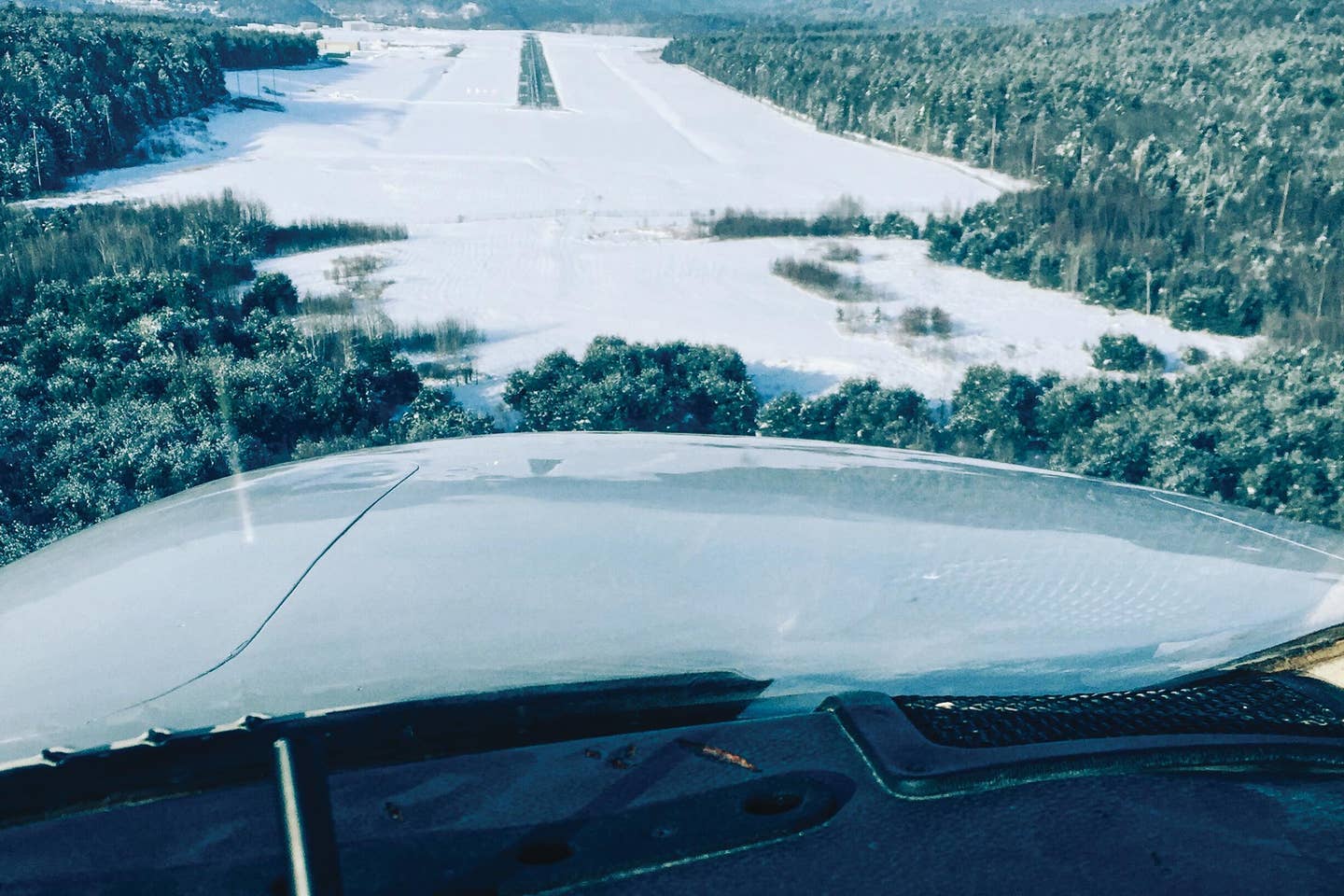
The runway, a black welcome mat surrounded by white snow, was waiting. Courtesy Dick Karl
Just when it seemed like the threat from the coronavirus was subsiding, fall turned to winter, and many of us were forced back inside. We soon got sick and tired of being cooped up. Our national mood seemed to be: enough already with the distancing, masks, 6-feet-apart thing. It soon became clear that people interpreted the threat and recommended public-health measures differently. It also became apparent that the situation could be used to further individual agendas. For example, I am an extrovert married to an introvert. One (me) wanted to invite friends to our home for dinner. The other (she) wanted to eat at a restaurant. We cautioned (shamed?) each other and stayed in and had no dinner parties.
Now, when it comes to flying airplanes, I will admit to being completely irrational. I am apparently immune not to COVID-19 but to accurate assessment of the risk of infection from it. I don’t care; I just want to fly. Larking about the country, I flew our airplane 10.6 hours this past October. When the surge of new virus cases became unavoidably obvious, calmer heads prevailed, and in November, it was 1.6 hours. I just didn’t have anywhere to go that warranted dying.
In December, we decided to fly from Tampa, Florida, to Lebanon, New Hampshire, where we had built a summer cottage. Oh, boy, I couldn’t wait. A white Christmas for certain, plus a great airplane ride. No crowds, no unknowns, and no real risk much different than staying at home. All we had to do was turn on the heat and water. But no kids or grandkids either; they were all being cautious. This was the smartest alternative but not the ideal one.
The cockpit layoff had had its consequences and some were even enjoyable. I paid way more attention to weight and balance, though I had profiled this flight many times before. I planned the trip on both fltplan.com and ForeFlight for days before the trip. Would there be enough tailwind to make the flight nonstop? Safely? You’d think I was prepping for a type-rating check ride. I relished all of this, though. The prospect of getting out, getting up, getting free of the miasma of life on pandemic Earth for a chance to soar above it all was renewing.
The night before our departure, 3 feet of snow fell in New Hampshire. The next day, the FBO emailed me at noon to report that the airport was still closed. When it did open, braking action was reported as 2/2/2—”medium to poor,” according to the FAA. Not good enough. There really wasn’t much to decide. If this were a Part 135 trip, we might have entertained waiting for better braking or picked a nearby alternate. But this was a personal Part 91 flight with a vigilant passenger. No need to stir up anxiety. I set my sights on a leisurely trip the next day.
Read More from Dick Karl: Gear Up
Preflight the night prior was more involved than usual. I savored every bit, got down on the ground to examine the tires, took more care inspecting the tail, touched the oxygen blowout disc, and spent more time looking for leaks than I can ever remember. Sitting favors neither the airplane nor the pilot.
With that in mind, I rehearsed the muscle memory of takeoff in my head on the drive to the airport. The winds looked favorable. The weather at each end was now excellent. Tailwinds of 37 knots were predicted over the route—just enough to land with 1,000 pounds of jet-A. Most pilots consider 800 pounds a safe minimum landing fuel; the book says 600 pounds, but I am conservative in these matters. I like 1,000 pounds.
Takeoff was to the north, with that favorite thrill of thrust. Good, we are already pointed in the right direction. Thirty-one minutes after takeoff, we were accelerating at Flight Level 390. It felt familiar. As we turned the corner in northern Florida and took up a northeasterly heading, groundspeed inched toward 400 knots. We were burning 720 pounds of fuel per hour. The Avidyne IFD550 predicted landing fuel at 951 pounds—so far so good. COVID felt far away up here. This was more like it.
ForeFlight showed Lebanon weather was holding. Light winds, good visibility, high pressure. Soon after, the ATIS confirmed all this, plus it reported windrows of snow. I reminded myself to look up and see what a windrow is. (It is “a long line of material heaped up by the wind.”)
The field was visible from 12 miles out. Boston Center has no radar coverage down low here, so we were cleared for the visual Runway 36 while still this far out, with a remaining instruction to call the tower. The runway, a black welcome mat surrounded by white snow, was waiting for us. The snow was pristine, fresh. Everything was a brilliant bright white in the slanted sunlight. Our landing reference speed was 98 knots, but I held 106 until retarding the throttles to idle at 50 feet. We floated a little. I didn’t want to experiment with braking action at the end of the runway, so I coaxed the airplane on. Braking was normal—taxi was not.
We taxied in gingerly. The linemen were bundled up. It was 19 degrees Fahrenheit. Cold enough. Shut down. As close to a perfect flight as I’ve ever experienced. Take that, COVID.
This story appeared in the April/May 2021 issue of Flying Magazine

Subscribe to Our Newsletter
Get the latest FLYING stories delivered directly to your inbox






